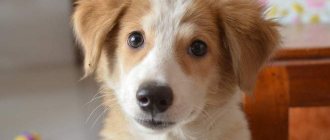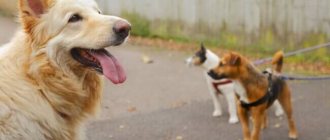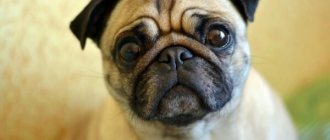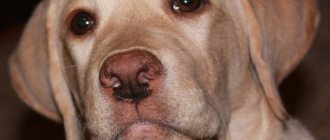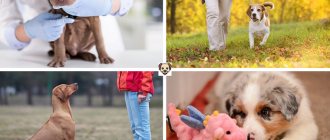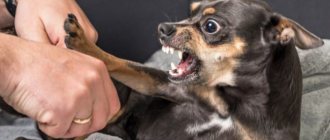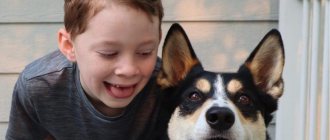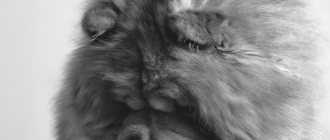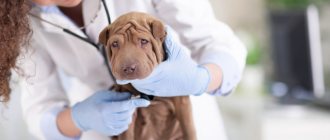Dog owners may often notice their pet sneezing. Most often, there is no reason to worry, since the dog simply frees the nasal passages from dust or accumulated mucus. In other words, it is a normal physiological process.
But if sneezing causes discomfort in the dog, is accompanied by lethargy, nasal discharge or other clinical manifestations, this is a reason to think that the pet has health problems. What symptoms threaten your four-legged friend and what diseases they could be we will look at in this article.
Causes of sneezing in dogs
Allergies (most often to environmental components - dust, pollen and many other irritants). The dog itches, sneezes, and clear mucus (snot) comes out of both nostrils. In addition to sneezing, the dog's eyes are leaking.
Possible swelling, difficulty breathing, even to the point that the dog is suffocating. There may be attacks of “sneezing” upon contact with an allergen. For example, if a pet has such a reaction to the pollen of a plant, then attacks become more frequent during a walk.
Infections , that is: viruses, bacteria, fungi. These factors can cause a huge list of diseases, the most common being canine distemper, adenovirus, coronavirus (respiratory form) and others...
Usually accompanied by lethargy, coughing and sneezing for a long time. The nose is stuffy, crusts form, conjunctivitis (discharge from the eyes). Over time, you can hear wheezing in the chest, the temperature rises, the nose is dry and warm.
In viral diseases, the snot is usually watery and transparent, and may thicken and become cloudy as the disease progresses.
With fungal infections, the discharge is viscous and smearing. This pathology is very painful for dogs, in severe cases it leads to deformation of the skull bones.
Foreign body in the nose. It could be a blade of grass or even a small stone. This usually happens to animals that constantly sniff the ground. The dog feels that something is preventing it from breathing normally and begins to snort, the receptors in the nose become irritated and it sneezes.
In cases where the pet is unable to get rid of the object in the nose on its own and it remains there for a long time, inflammation and swelling develop, which makes breathing even more difficult for the pet.
Local irritation. This happens in cases where the pet inhales caustic substances, such as smoke, perfume, or something from household chemicals. In this case, the symptoms begin to appear very quickly and sharply - the dog sneezes, rubs his nose with his paws, the discharge in this case is liquid and transparent.
Very severe inflammation develops. Sometimes there can be a chemical burn to the mucous membrane if the pet has inhaled some household chemicals.
Injury. The dog can get injured on its own, or as a consequence of surgical interventions, and sometimes because of a foreign object or an unsuccessful attempt to pull it out.
In this case, the dog sometimes sneezes blood from the nose, while it experiences pain, jerks its head, and backs away.
Tumor or polyp (in one word - neoplasm). It manifests itself in the same way as a foreign body in the nasal cavity, which interferes with normal breathing, but becomes chronic and responds little to treatment. Therefore, it makes no sense to start treating if you have not eliminated the cause of the disease - you need to remove the tumor.
Otherwise, you will relieve swelling and local irritation only for a while. Meanwhile, the tumor may increase in size. If these were polyps, then even after removal they tend to grow again, therefore, periodic examinations will be needed to ensure timely removal and prevent the growth of new polyps.
Parasites (ticks, fleas, helminths). Firstly, animals have a specific allergic reaction to the saliva of a flea or tick. Secondly, it is important to know that helminths (parasitic worms) live not only in the intestines.
There are also pulmonary helminthiases, in which case the parasites live in the bronchi of the lungs and can move up the respiratory tract. In this case, irritation of the mucous membrane occurs, the dog coughs and sneezes. Sometimes you can even observe that small worms fly out along with the mucus.
Diseases not related to the respiratory (respiratory) system - diseases of the urinary system, gastrointestinal tract, etc., can also cause sneezing. And this happens through a weakened immune system, the body becomes less resistant to bacteria and viruses, nasal discharge appears, and therefore sneezing.
In this case, you can cure a runny nose, but it will soon return until the underlying disease disappears and immunity is restored.
Frontal sinusitis is an inflammation of the frontal sinus, similar to sinusitis in humans. As a rule, it is caused by infections (both viral and bacterial etiology), or as a complication of other diseases of the respiratory system.
With this disease, the dog sneezes and produces a large amount of mucus. At the beginning of the disease, the exudate (discharge) is liquid and transparent, and the further the disease progresses, the denser and greener the discharge becomes. You shouldn’t let the disease get to this point.
Stress, anxiety, a tight collar - in these cases, sneezing is a normal process that does not require concern.
Entry of foreign bodies into the nasal cavity
While walking, dogs explore with their noses everything they encounter along the way. If your dog, while walking, starts snorting and sneezing, waving his head, or rubbing his nose with his paw, then there is a high probability that something has gotten into his nose. There may be blood and copious mucous discharge from the nose. In such a case, the dog owner urgently needs to examine its nose and try to remove any foreign objects with tweezers. If this cannot be done, the dog must be urgently taken to a veterinary clinic to remove foreign objects from the nasal cavity.
Reverse sneeze syndrome
It looks as if the dog is sneezing into itself, while the dog sometimes takes an unnatural pose and the sounds that the animal makes at the same time resemble an asthmatic attack. This picture often frightens the owner, but most often does not pose any danger to the dogs.
If after an attack the pet behaves as usual, the appetite and temperature are normal, then there is no need to worry.
A reverse sneezing attack can be caused by stress, a tight collar, inhalation of caustic substances, and some other factors.
This process is a spasm of the larynx. Representatives of brachycephalic breeds are especially prone to this due to the characteristics of their deformed skull.
Specialist help and dog treatment
An early visit to the doctor will help avoid many complications. It is in a clinical setting that all the necessary examinations can be carried out and a correct diagnosis can be made. After an external examination and palpation, the animal’s temperature will be taken and the oral cavity will be examined. They may order tests and an x-ray.
Most often, a specialist prescribes drug therapy. Antibiotics, anthelmintics and various other drugs are used according to the symptoms.
Always follow your doctor's orders. Under no circumstances give animals any traditional tinctures or vodka. They can cause severe poisoning, which can lead to death.
At-risk groups
Most often, sneezing can be observed in animals kept outside, since they are forced to be in drafts and are more often exposed to hypothermia than other dogs.
Brachycephalic breeds such as Pugs, Pekingese, Boston Terriers, Bulldogs, Shih Tzus, Boxers and others. Due to the structure of their skulls, they can often be observed grunting, snoring, snoring, and sneezing, and they are also often observed to have reverse sneeze syndrome.
This always indicates that the animal is having difficulty breathing. People have made such a pathology a breed feature. You don't need to close your eyes to it. If symptoms occur frequently and interfere with the dog’s normal life, you should consult a veterinarian. You may need surgery to make breathing easier.
Sneezes and snorts
Snorting is a sign that your pet is trying to clear his sinuses . If the lobe is clean and there is no discharge, then the cause lies in a foreign object. In this case, a prolonged act of sneezing and other symptoms are noted:
- Anxiety (the dog rubs its nose with its paws);
- Difficulty breathing (the dog cannot draw in air and snorts);
- Coughing attacks are possible when the posterior connective tissue is blocked.
If your dog is sneezing heavily for several days, there is a reason to see a veterinarian. A single or double sneeze should not cause panic among owners.
The veterinarian will surgically remove the object. After which antiseptics (Anadin) and a course of antibiotics (Polydex) will be prescribed. It is important to show your pet to a doctor after treatment to conduct a final rhinoscopy to confirm the fact of recovery.
Another problem that causes a similar reaction is severe bruising. In this case, pain will occur when you press the spout. Injury can be caused by a sharp branch, a cat, or even a bee sting.
All cuts, injections or bruises of the lobe are very painful, because important receptors are located on the tailed nose. The owner can treat the edges with a solution of sodium permanganate or brilliant green, and seal it with a band-aid there so as not to close the nostrils.
Treatment
Treatment should be prescribed by a veterinarian after an in-person examination of the dog.
Because in order to take action for the dog’s recovery, it is necessary to determine the cause of the disease, and this is not always possible at home.
What to do before visiting the clinic?
First, examine your nasal passages. It is advisable to use a flashlight to illuminate your nose. This way you can detect foreign objects if there are any. Also, you will immediately see if there is swelling and redness; these are the first signs of inflammation.
Remove dirt and crusts around the nose using a cotton pad moistened with plain warm water.
To reduce inflammation, it is safe to use Anandin drops or a 0.15% Maksidin solution, one drop in each nostril. These drops are a complex preparation against bacteria. Helps relieve swelling and promotes tissue healing.
If after a couple of days the sneezing does not go away, does not become weaker, and the dog exhibits other symptoms - lethargy, loss of appetite, fever, you should immediately consult a doctor. There is always a danger that the dog has contracted a viral infection, which is very dangerous for the pet’s life!
Allergy
Dogs see the world around them mostly through their nose; dogs have a highly developed sense of smell (smell in dogs). In modern life, when in recent decades a large number of artificial odors have appeared, plus an additionally extremely difficult environmental situation, especially around large cities, dogs with allergies, like people with allergies, are not uncommon.
The following can serve as an allergy agent for dogs:
- Household chemicals (washing powder, deodorants), perfumes, perfumes, etc.
- Pollen is a strong allergen for dogs; in the spring, dogs often develop seasonal allergies to certain plants.
- Mold.
- Dust, including from carpets, books, etc.
- Tobacco smoke, especially when the owners are non-smokers, and on the street (at the entrance) you and your dog pass by a smoking person.
- In summer, dogs are often susceptible to allergies as a result of insect bites; a dog bite from a snake is especially dangerous.
- The use of a flea collar may cause allergies in some dogs.
- Often the source of allergies is dog food (food allergies in animals).
Allergy symptoms in dogs are accompanied by constant sneezing, watery eyes, coughing, snot, and skin itching (itching in dogs).
If your dog develops an allergy, you need to urgently contact your veterinary clinic, where veterinary specialists will determine the cause of the allergy and prescribe appropriate treatment and give recommendations on feeding and keeping the dog.
Prevention
- It is necessary to vaccinate your animal against viral diseases in a timely manner!
- The dog should have a well-equipped “place”. If she lives in a house, then she should not lie on a cold floor or draft.
- If the dog lives on the street, he must have an insulated booth. And, despite the fact that he lives in the yard, he still needs to be walked to provide sufficient exercise and socialization. Otherwise, the dog will not have sufficient immunity.
- Periodic treatments against internal and external parasites are required!
Tips and Tricks to Speed Up Healing
REST AND GOOD HYDRATION
To help your dog recover from a cold, you will simply follow the same rules as you would for a cold. Do not leave your dog and let him rest in a warm place. She probably suffers from body aches and headaches. Place her on a thick, comfortable and warm blanket. Leave fresh water available to hydrate and change it regularly. If she doesn't want to eat, don't force her, but try to get her attention with your favorite treat. You can also make chicken broth to drink.
NATURAL REMEDIES FOR DOG COLDS
To rid your dog of a cold, you can make him take a steam bath . Stay with your dog in a closed room and let the hot water run until steam penetrates the space. This 100% natural method will cleanse your bronchi and soothe them like a steam bath. To enhance the calming effect of a steam bath, add a few drops of Eucalyptus radialis essential oil to the water. Be careful not to get the essential oil on your dog's skin.
My dog has a cold: when should I check? As soon as your dog seems feverish and depressed, veterinary consultation is highly recommended. A common cold can get worse if it is not treated properly. A defeated dog that refuses to feed needs medical attention.
Briefly about the main thing
- The causes of sneezing can be: allergies, infection, foreign body, local irritation, trauma, neoplasm, parasites, frontal sinusitis, stress.
- Reverse sneezing syndrome can sometimes be observed in dogs. It may look scary, but unless there are other accompanying symptoms, there is often no need to worry.
- At risk are pets with weakened immune systems and those that are often exposed to drafts and are exposed to hypothermia. As well as representatives of brachycephalic breeds.
- Treatment should be prescribed by a veterinarian after determining the cause.
- For prevention, it is necessary to vaccinate the animal in a timely manner, treat it against parasites and provide the dog with a warm “place” without drafts.
When do you need veterinary help?
Before considering options for eliminating this problem and taking any action, it is worth determining the level of danger facing the dog. To find out why a dog sneezes and snorts and what it means, you need to take into account its age, breed and body type.
As you know, in dogs with flattened noses, sneezing or snorting is a normal phenomenon, so you should not unduly focus on it. If you see that your pet’s health is deteriorating before your eyes, you must immediately take him to the veterinary clinic.
The main dangerous symptoms that accompany sneezing are the presence of diarrhea, fever, weakness and inactivity of the dog, loss of interest in everything that is happening, chills, discharge from the nostrils and eyes.
